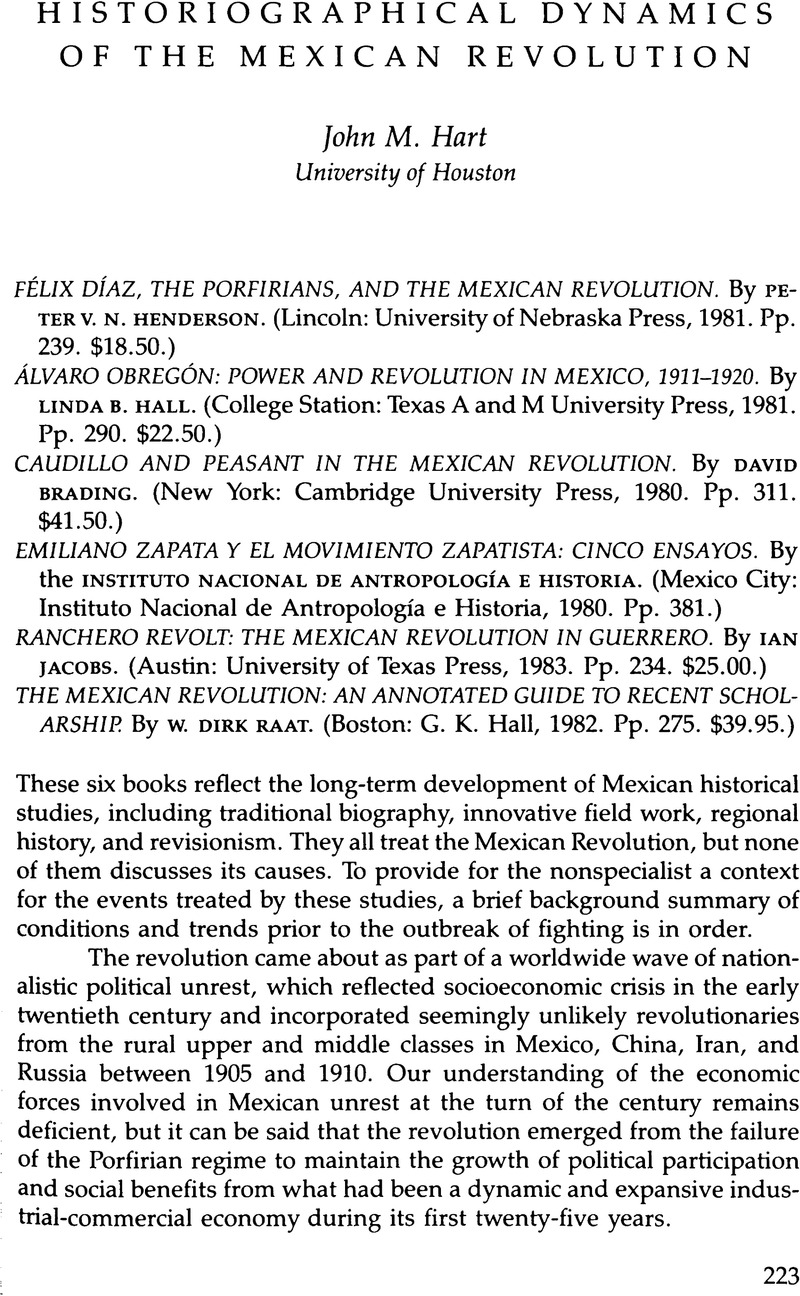No CrossRef data available.
Article contents
Historiographical Dynamics of the Mexican Revolution
Review products
Published online by Cambridge University Press: 24 October 2022
Abstract

- Type
- Review Essays
- Information
- Copyright
- Copyright © 1984 by Latin American Research Review
References
Notes
1. For reports on corn imports and the chaos of Porfirian domestic agriculture between 1907 and 1910, see the Daily Consular and Trade Reports, issued by the Bureau of Manufactures, Department of Commerce and Labor. For example, Consul Edwin S. Cunningham, “Production of Indian Corn in South Africa,” Durban, Natal, no. 115, 16 November 1910; Consul Clarence A. Miller, “Mexican Importations of Grain,” Tampico, no. 115, 27 October 1910; and Miller, “Heavy American Exports to Mexico,” no. 107, 7 November 1910.
2. The International Railroad, which ran from Durango through Torreón and Monclova to Eagle Pass, suffered a 16-percent decline in freight profits in 1908–9 and a 9.3-percent decline in freight tonnage due to the calamitous failure of the cotton and corn crops. The Interoceanic Railroad hauled 9 percent less tonnage between Mexico City and the port of Veracruz. Mexican silver production fell about 7 percent while the value per ounce dropped 20 percent. The best source on the post-1905 Porfirian economic crisis is the Commercial and Financial Chronicle (New York). Railroad data can be found in Volume 89, pp. 1570 and 1594, 18 December 1909. Information on silver abounds. For example, see Volume 88, p. 480, 20 February 1909, and Volume 87, p. 1063, 24 October 1908, p. 1163, 31 October 1908, and p. 1383, 28 November 1908.
3. Commanding Officer, Second Cavalry Brigade, Douglas, Arizona, to the Commanding General, Southern Department, Fort Sam Houston, Texas, 8 June 1914, “Mexican Intervention.” “Mexican Intervention,” Records Group 92 (2149991), National Archives (Old Army and Navy Office), Washington, D.C.
4. Ibid.
5. The following U.S. Consular Report confirms Eulalio Gutiérrez's radicalism:
A decree issued under date September 15, 1914, by Governor Eulalio Gutierrez, fixes the minimum wage in the State of San Luis Potosi at 73 centavos per day, to be paid in cash. … The 9-hour day is also decreed. Employers who have been paying more than the minimum are forbidden to reduce wages to the minimum. Workers on farms must be supplied free water, wood and shelter. By the same decree, company stores are abolished. All debts contracted by laborers are exempt from garnishment. … Probably the most important article in the decree provides that in view of the exceedingly low wages heretofore prevailing, all loans and advances heretofore made and now outstanding against the laborers, must be considered as a voluntary supplement to the inadequate wages and are therefore declared liquidated and canceled.
Consul Wilbert L. Bonney, “New Labor Law in Mexico,” San Luis Potosí, Daily Consular and Trade Reports, no. 238, 10 October 1914.
6. See Frans J. Schryer, The Rancheros of Pisaflores: The History of a Peasant Bourgeoisie in Twentieth-Century Mexico (Toronto: University of Toronto, 1980), p. 210.
7. Theda Scokpol, States and Social Revolutions: A Comparative Analysis of France, Russia, and China (Cambridge and New York: Cambridge University Press, 1979), 407 pp.


